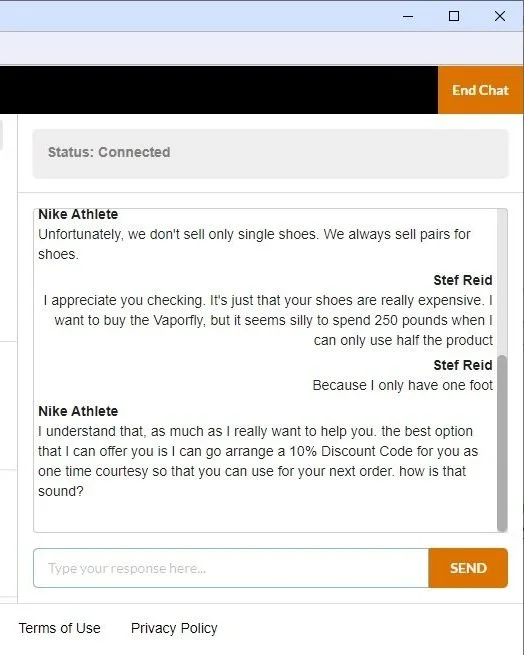Diversity and Inclusion: Brand marketing vs Brand policies
“Hi Nike. Is it possible to buy just one shoe because I only have one foot?”
My sister recently sent me a photo of a mannequin wearing a running blade from a Nike store in Seattle. It made me really happy. I’ve been an amputee for almost 24 years and I’ve never seen myself reflected in running culture. A few weeks later, my friend sent me another photo of a similar mannequin from a store in London, while another friend spotted one in New York. I thought, “Amazing! It’s gone world wide!!!
But then I asked the obvious question. And this was the response from Nike:
It’s been a week, and in addition to not hearing back from Nike, I discovered that other companies like Decathlon and Brooks were also using images of single leg amputees to promote their running brands but not offering the practical thing that all blade runners need: the option to buy one running shoe instead of two.
Nike, I like your shoes. That’s why I want to buy them. And I love that you are using amputee mannequins. I lost part of my right leg in an accident when I was 16. I know how special it would have been for me to have seen that as a new amputee.
But if you are going to use the image, you need to back it up in the way you do business. Of course companies want to brand themselves as inclusive. The problem is too many want the feel good marketing without doing the hard work. It has to be supported by changes in policies and procedures across your business.
But this is bigger than me, this is bigger than amputees, and this is bigger than disability. This is an example of how thinking inclusively can set you apart in a very competitive shoe market while delivering a better product and better experience for all customers.
Nike prides itself on having the best road racing shoes. They have done the hard work in terms of research, perfecting the foam and the carbon plate and the shape of their shoes to give boost energy return. But they’ve missed the simple step of offering the option to buy shoes in singles. Again, forget leg amputees or disability. 50-60% of adults have differently sized feet. If you are buying expensive, carbon plated shoes, you obviously care about your performance. What could be more high performance than offering your customers a perfect fit for each foot t instead of asking runners to make do with the status quo?
The shoe industry is stuck in a mindset that doesn't reflect reality. The contact lens industry doesn’t assume all eyes are the same. I wear contacts and I’ve never bought them in pairs. My optometrist always writes a separate prescription. The customer experience reflects the fact that body parts don’t always match. It’s time for the shoe industry to catch up.
This is where you find the high performance power of diversity and inclusion. Not only is it the right thing to do, but it will make you better. It’s an opportunity to consider current a different perspective and break free from the definition of “normal” that all your competitors are using.











